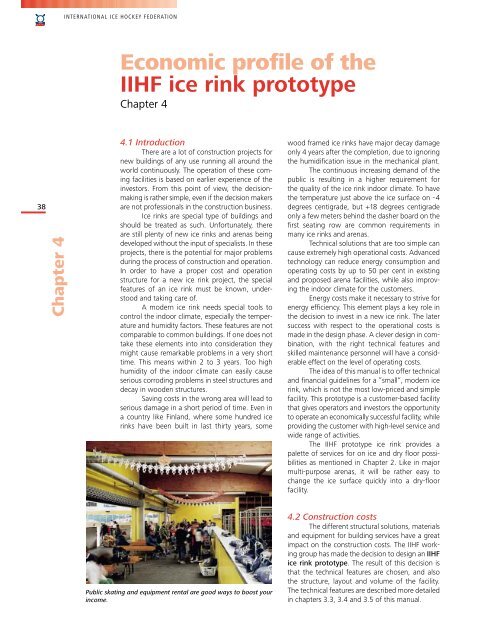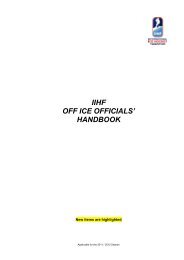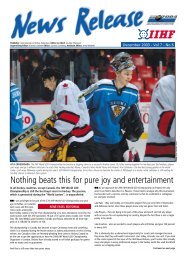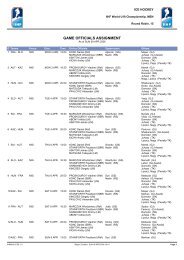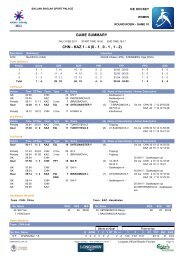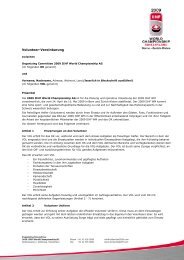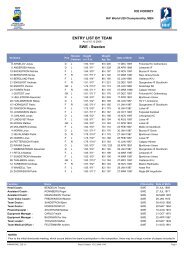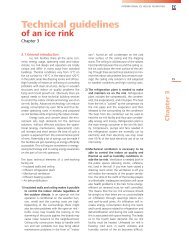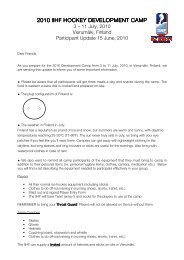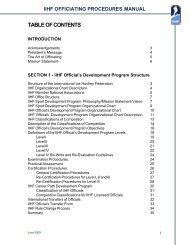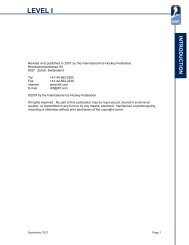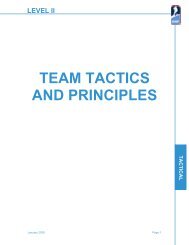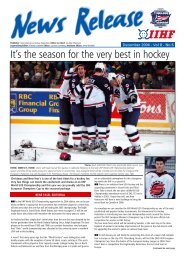Economic profile of the IIHF ice rink prototype
Economic profile of the IIHF ice rink prototype
Economic profile of the IIHF ice rink prototype
Create successful ePaper yourself
Turn your PDF publications into a flip-book with our unique Google optimized e-Paper software.
38<br />
Chapter 4<br />
INTERNATIONAL ICE HOCKEY FEDERATION<br />
<strong>Economic</strong> <strong>pr<strong>of</strong>ile</strong> <strong>of</strong> <strong>the</strong><br />
<strong>IIHF</strong> <strong>ice</strong> <strong>rink</strong> <strong>prototype</strong><br />
Chapter 4<br />
4.1 Introduction<br />
There are a lot <strong>of</strong> construction projects for<br />
new buildings <strong>of</strong> any use running all around <strong>the</strong><br />
world continuously. The operation <strong>of</strong> <strong>the</strong>se coming<br />
facilities is based on earlier experience <strong>of</strong> <strong>the</strong><br />
investors. From this point <strong>of</strong> view, <strong>the</strong> decisionmaking<br />
is ra<strong>the</strong>r simple, even if <strong>the</strong> decision makers<br />
are not pr<strong>of</strong>essionals in <strong>the</strong> construction business.<br />
Ice <strong>rink</strong>s are special type <strong>of</strong> buildings and<br />
should be treated as such. Unfortunately, <strong>the</strong>re<br />
are still plenty <strong>of</strong> new <strong>ice</strong> <strong>rink</strong>s and arenas being<br />
developed without <strong>the</strong> input <strong>of</strong> specialists. In <strong>the</strong>se<br />
projects, <strong>the</strong>re is <strong>the</strong> potential for major problems<br />
during <strong>the</strong> process <strong>of</strong> construction and operation.<br />
In order to have a proper cost and operation<br />
structure for a new <strong>ice</strong> <strong>rink</strong> project, <strong>the</strong> special<br />
features <strong>of</strong> an <strong>ice</strong> <strong>rink</strong> must be known, understood<br />
and taking care <strong>of</strong>.<br />
A modern <strong>ice</strong> <strong>rink</strong> needs special tools to<br />
control <strong>the</strong> indoor climate, especially <strong>the</strong> temperature<br />
and humidity factors. These features are not<br />
comparable to common buildings. If one does not<br />
take <strong>the</strong>se elements into into consideration <strong>the</strong>y<br />
might cause remarkable problems in a very short<br />
time. This means within 2 to 3 years. Too high<br />
humidity <strong>of</strong> <strong>the</strong> indoor climate can easily cause<br />
serious corroding problems in steel structures and<br />
decay in wooden structures.<br />
Saving costs in <strong>the</strong> wrong area will lead to<br />
serious damage in a short period <strong>of</strong> time. Even in<br />
a country like Finland, where some hundred <strong>ice</strong><br />
<strong>rink</strong>s have been built in last thirty years, some<br />
Public skating and equipment rental are good ways to boost your<br />
income.<br />
wood framed <strong>ice</strong> <strong>rink</strong>s have major decay damage<br />
only 4 years after <strong>the</strong> completion, due to ignoring<br />
<strong>the</strong> humidification issue in <strong>the</strong> mechanical plant.<br />
The continuous increasing demand <strong>of</strong> <strong>the</strong><br />
public is resulting in a higher requirement for<br />
<strong>the</strong> quality <strong>of</strong> <strong>the</strong> <strong>ice</strong> <strong>rink</strong> indoor climate. To have<br />
<strong>the</strong> temperature just above <strong>the</strong> <strong>ice</strong> surface on -4<br />
degrees centigrade, but +18 degrees centigrade<br />
only a few meters behind <strong>the</strong> dasher board on <strong>the</strong><br />
first seating row are common requirements in<br />
many <strong>ice</strong> <strong>rink</strong>s and arenas.<br />
Technical solutions that are too simple can<br />
cause extremely high operational costs. Advanced<br />
technology can reduce energy consumption and<br />
operating costs by up to 50 per cent in existing<br />
and proposed arena facilities, while also improving<br />
<strong>the</strong> indoor climate for <strong>the</strong> customers.<br />
Energy costs make it necessary to strive for<br />
energy efficiency. This element plays a key role in<br />
<strong>the</strong> decision to invest in a new <strong>ice</strong> <strong>rink</strong>. The later<br />
success with respect to <strong>the</strong> operational costs is<br />
made in <strong>the</strong> design phase. A clever design in combination,<br />
with <strong>the</strong> right technical features and<br />
skilled maintenance personnel will have a considerable<br />
effect on <strong>the</strong> level <strong>of</strong> operating costs.<br />
The idea <strong>of</strong> this manual is to <strong>of</strong>fer technical<br />
and financial guidelines for a ”small“, modern <strong>ice</strong><br />
<strong>rink</strong>, which is not <strong>the</strong> most low-pr<strong>ice</strong>d and simple<br />
facility. This <strong>prototype</strong> is a customer-based facility<br />
that gives operators and investors <strong>the</strong> opportunity<br />
to operate an economically successful facility, while<br />
providing <strong>the</strong> customer with high-level serv<strong>ice</strong> and<br />
wide range <strong>of</strong> activities.<br />
The <strong>IIHF</strong> <strong>prototype</strong> <strong>ice</strong> <strong>rink</strong> provides a<br />
palette <strong>of</strong> serv<strong>ice</strong>s for on <strong>ice</strong> and dry floor possibilities<br />
as mentioned in Chapter 2. Like in major<br />
multi-purpose arenas, it will be ra<strong>the</strong>r easy to<br />
change <strong>the</strong> <strong>ice</strong> surface quickly into a dry-floor<br />
facility.<br />
4.2 Construction costs<br />
The different structural solutions, materials<br />
and equipment for building serv<strong>ice</strong>s have a great<br />
impact on <strong>the</strong> construction costs. The <strong>IIHF</strong> working<br />
group has made <strong>the</strong> decision to design an <strong>IIHF</strong><br />
<strong>ice</strong> <strong>rink</strong> <strong>prototype</strong>. The result <strong>of</strong> this decision is<br />
that <strong>the</strong> technical features are chosen, and also<br />
<strong>the</strong> structure, layout and volume <strong>of</strong> <strong>the</strong> facility.<br />
The technical features are described more detailed<br />
in chapters 3.3, 3.4 and 3.5 <strong>of</strong> this manual.
<strong>IIHF</strong> <strong>prototype</strong> <strong>ice</strong> <strong>rink</strong><br />
Lemminkäinen Construction Ltd.<br />
31.1.2002<br />
Cost groups according to DIN 276 Preliminary cost estimate %<br />
100 Site costs<br />
200 Utilities<br />
300 Construction costs 1,341,097 57.84<br />
310 Earth works 123,855<br />
320 Foundation (incl. <strong>ice</strong> pad) 265,825<br />
330 External walls 118,220<br />
340 Internal walls 138,240<br />
350 Ceilings 110,325<br />
360 Ro<strong>of</strong>ing 193,400<br />
370 Fittings 366,232<br />
390 O<strong>the</strong>r construction works 25,000<br />
400 Mechanical and electrical works 479,600 20.68<br />
410 Sewage, plumbing 79,200<br />
420 Heating 35,200<br />
430 Ventilation, Dehumidification 118,800<br />
440 Electricity, high voltage 110,000<br />
450 Telefommunication, data network, etc. 17,600<br />
460 Elevators 0<br />
470 Refrigeration unit 79,200<br />
480 Building automation 30,800<br />
490 O<strong>the</strong>r M&E works 8,800<br />
500 Site finishing 100,000 4.31<br />
510 Yard works 25,000<br />
520 Yard finishing 25,000<br />
530 External construction works 40,000<br />
540 External M&E works 10,000<br />
550 External fittings 0<br />
590 O<strong>the</strong>r external works 0<br />
600 Equipment 165,000 7.12<br />
610 Equipment (<strong>ice</strong> resurfacer, dasher board, score board etc.) 165,000<br />
700 Design, project management 233,000 10.05<br />
710 Project supervisor 35,000<br />
720 Project preliminary costs 10,000<br />
730 Architect design and engineering 150,000<br />
740 Inspection fees etc. 8,000<br />
750 Art works 0<br />
760 Financing 0<br />
770 General project costs 25,000<br />
790 O<strong>the</strong>r costs 5,000<br />
Cost groups 100-700 total € 2,318,697 100.00<br />
General project development costs (8%) € 197,089<br />
Total project costs (netto) € 2,515,786<br />
Some special notes:<br />
1) Cost structure finally depends on <strong>the</strong> operational construction realization (MC, CM, DMC...), calculation for location Munich, Germany<br />
2) Cost groups 100 and 200 must be defined separately based on <strong>the</strong> site characteristics<br />
INTERNATIONAL ICE HOCKEY FEDERATION<br />
Chapter 4<br />
39
40<br />
Chapter 4<br />
INTERNATIONAL ICE HOCKEY FEDERATION<br />
This is a turn-key cost estimate for <strong>IIHF</strong><br />
<strong>prototype</strong> <strong>ice</strong> <strong>rink</strong>. The <strong>IIHF</strong> working group would<br />
like to underline that this cost calculation is not<br />
a cost guarantee in any form. This calculation<br />
merely gives you as an investor, developer or sports<br />
enthusiast, a good indication <strong>of</strong> <strong>the</strong> total cost<br />
when you have decided to build a small <strong>ice</strong> <strong>rink</strong>.<br />
Between continents and countries <strong>the</strong> construction<br />
costs are going to vary, even when we<br />
use <strong>the</strong> same technical definitions. The cost estimate<br />
shown in <strong>the</strong> manual is based on <strong>the</strong> location<br />
in <strong>the</strong> city <strong>of</strong> Munich, Germany.<br />
Please be aware that lower labour costs in<br />
some countries in comparison with <strong>the</strong> cost level<br />
in Germany automatically lead to notable savings.<br />
In many cases <strong>the</strong> lower labour cost level is balanced<br />
by paying extra on import taxes <strong>of</strong> technical<br />
equipment or by <strong>the</strong> increasing number <strong>of</strong> employees<br />
because <strong>of</strong> <strong>the</strong> lack <strong>of</strong> machines.<br />
The model <strong>of</strong> <strong>the</strong> cost calculation is based<br />
on <strong>the</strong> German DIN 276 – form, which is widely<br />
been used in Central Europe. On <strong>the</strong> o<strong>the</strong>r hand it<br />
is ra<strong>the</strong>r easy to transform this cost estimate into<br />
ano<strong>the</strong>r calculation form.<br />
The costs <strong>of</strong> <strong>the</strong> site and <strong>the</strong> utilities are not<br />
included in <strong>the</strong> total summary. These are also <strong>the</strong><br />
items <strong>of</strong> <strong>the</strong> costs in order to have neutrality in <strong>the</strong><br />
cost estimate.<br />
4.3 Operational budget<br />
4.3.1 Expenses<br />
The major utilities required in an <strong>ice</strong> <strong>rink</strong><br />
operation are electricity, gas, and water. Also<br />
monthly fees related to <strong>the</strong> external financing (see<br />
chapter 5), mortgage payments, should be looked<br />
at on a case-by-case basis.<br />
Maintaining a sheet <strong>of</strong> <strong>ice</strong> is a 24-hour<br />
commitment. The owners cannot simply turn <strong>of</strong>f<br />
<strong>the</strong> electricity to <strong>the</strong> refrigeration plant when <strong>the</strong><br />
building is closed. There are proven methods to<br />
efficiently operate an <strong>ice</strong> <strong>rink</strong>.<br />
It is also important to work with <strong>the</strong> local<br />
utility companies to establish favourable agreements<br />
for <strong>the</strong> facility. A common way to reduce<br />
<strong>the</strong> fixed costs is to negotiate partner agreements<br />
with a local telephone company or a local<br />
garbage disposal company or o<strong>the</strong>r similar companies.<br />
When making <strong>the</strong> budget for <strong>the</strong> operational<br />
costs one should take into consideration<br />
<strong>the</strong> tasks that could be fulfilled by volunteers. This<br />
possibility would improve cost reduction. The tasks<br />
could be:<br />
• Maintenance <strong>of</strong> <strong>the</strong> facility<br />
• Cleaning<br />
• Ice resurfacer maintenance<br />
Also mechanical serv<strong>ice</strong> contracts have<br />
to be included. Specialised work that has to be<br />
done by experts, which could include maintenance<br />
<strong>of</strong> <strong>the</strong> refrigeration plant and <strong>the</strong> <strong>ice</strong> resurfacer.<br />
List <strong>of</strong> monthly expenses<br />
✔ Financing costs<br />
✔ Utilities – electricity<br />
✔ Utilities – gas<br />
✔ Utilities – water, sewer<br />
✔ Insurance - Liability and Property<br />
✔ Real estate taxes<br />
✔ O<strong>the</strong>r taxes l<strong>ice</strong>nses and fees<br />
✔ Telephone<br />
✔ Off<strong>ice</strong> expenses<br />
✔ Cleaning supplies<br />
✔ Trash removal<br />
✔ Facility maintenance<br />
✔ Personnel costs<br />
Personnel<br />
All <strong>ice</strong> facilities require a competent, welltrained<br />
staff to help <strong>the</strong> <strong>rink</strong> succeed. As previously<br />
noted, <strong>the</strong> cost to open an <strong>ice</strong> facility is<br />
substantial. It is important to have a staff that<br />
understands <strong>the</strong> <strong>ice</strong> business and can operate <strong>the</strong><br />
facility at maximum efficiency and pr<strong>of</strong>itability.<br />
Due to <strong>the</strong> fact that a single sheet facility may<br />
operate for 18 hours a day, 7 days a week, <strong>the</strong><br />
facility will need related man-hours to cover <strong>the</strong><br />
operation.<br />
In some countries, it is possible to utilize<br />
volunteer staff to cover many <strong>of</strong> <strong>the</strong> hours. However<br />
one should be aware that volunteer work<br />
ethics and expertise might be lacking. For a successful<br />
operation, <strong>the</strong> total number <strong>of</strong> staff can be<br />
adjusted. With larger public sessions or special<br />
events, a bigger staff will be necessary.<br />
The <strong>rink</strong> manager is <strong>the</strong> key to a successful<br />
operation. The manager must oversee <strong>the</strong><br />
whole spectrum <strong>of</strong> activities and serv<strong>ice</strong>s and<br />
should operate a customer-based operation. The
ink manager should be <strong>the</strong> driving force behind<br />
<strong>the</strong> facility.<br />
The duties <strong>of</strong> <strong>the</strong> manager in a single sheet<br />
operation include, but are not limited to, <strong>the</strong><br />
following areas:<br />
✔ Personnel Administration<br />
✔ Human Resource Management<br />
✔ Ice Scheduling<br />
✔ Ice Contracts<br />
✔ Marketing<br />
✔ Facility Maintenance<br />
✔ Budgeting<br />
It is necessary to have at least two assistant<br />
<strong>rink</strong> managers (<strong>rink</strong> technicians). The assistant<br />
<strong>rink</strong> managers typically take care <strong>of</strong> <strong>the</strong><br />
evenings and weekends at <strong>the</strong> facility. It is <strong>the</strong>ir<br />
responsibility to schedule part time staff, maintain<br />
<strong>the</strong> facility, and serve as <strong>the</strong> main customer<br />
serv<strong>ice</strong> person for <strong>the</strong> public. They are also responsible<br />
for <strong>ice</strong> maintenance and resurfacing <strong>the</strong> <strong>ice</strong>.<br />
A facility should also have one full time,<br />
multitalented secretary. The secretary fills a variety<br />
<strong>of</strong> roles, including receptionist, registrar, and accountant.<br />
This person must also have knowledge<br />
<strong>of</strong> all <strong>the</strong> programs <strong>of</strong>fered at <strong>the</strong> <strong>rink</strong>, to immediately<br />
answer questions from <strong>the</strong> general public.<br />
In addition to this staff, a single sheet facility<br />
may have 2 to 3 additional part time operations<br />
staff that can drive <strong>the</strong> <strong>ice</strong> resurfacer, work<br />
evening or weekend shifts, maintain <strong>the</strong> building<br />
and keep it clean.<br />
As <strong>the</strong> <strong>ice</strong> <strong>rink</strong> industry evolves and<br />
changes, it is important to keep staff up to date<br />
on <strong>the</strong> latest advancements in <strong>the</strong> industry. With a<br />
plan for staff training and education, <strong>rink</strong> operators<br />
will have <strong>the</strong> opportunity to learn more<br />
efficient and cost effective methods to running an<br />
<strong>ice</strong> <strong>rink</strong>. A budget should be created to cover<br />
training course registrations and expenses.<br />
In many areas <strong>of</strong> <strong>the</strong> world, <strong>the</strong> user<br />
groups such as <strong>the</strong> hockey or figure skating clubs<br />
will take responsibility for <strong>the</strong> programs on <strong>the</strong> <strong>ice</strong>.<br />
In o<strong>the</strong>r parts <strong>of</strong> <strong>the</strong> world, depending on <strong>the</strong> type<br />
<strong>of</strong> <strong>rink</strong> operation and <strong>the</strong> region, <strong>the</strong>re are several<br />
o<strong>the</strong>r positions that may be added to <strong>the</strong> full time<br />
staff. A skating director would handle all Learn to<br />
Skate and figure skating programs in <strong>the</strong> facility.<br />
This person would serve, as a teaching pr<strong>of</strong>essional<br />
in <strong>the</strong> Learn to Skate program, would hire<br />
o<strong>the</strong>r skating coaches, and coordinate all skating<br />
programs. A hockey director would operate in a<br />
similar manner to manage <strong>the</strong> hockey operations<br />
at <strong>the</strong> facility. If necessary, a marketing director<br />
may be hired to promote <strong>the</strong> facility and <strong>the</strong><br />
many diverse programs that are <strong>of</strong>fered to <strong>the</strong><br />
community.<br />
If <strong>the</strong> <strong>rink</strong> expands to include a concession<br />
stand or a pro shop, both a concession manager<br />
and a pro shop manager would be required.<br />
Personnel list<br />
✔ Rink Manager<br />
✔ Technical Staff (2)<br />
✔ Off<strong>ice</strong> Secretary<br />
✔ Part-time operations staff (2-3)<br />
✔ Part time maintenance staff<br />
INTERNATIONAL ICE HOCKEY FEDERATION<br />
It is also to be not<strong>ice</strong>d, that an <strong>ice</strong> <strong>rink</strong><br />
with two <strong>ice</strong> pads can be operated with <strong>the</strong><br />
same amount <strong>of</strong> staff as <strong>the</strong> single <strong>ice</strong> surface<br />
<strong>rink</strong>s. O<strong>the</strong>r expenses, such as energy, can be<br />
reduced in comparison with <strong>the</strong> doubled user<br />
capacity <strong>of</strong> <strong>the</strong> facility.<br />
Percentage <strong>of</strong> expenses<br />
� Water 4%<br />
� Sewage 3%<br />
� Electricity (energy cost) 27%<br />
� Staff 50%<br />
� O<strong>the</strong>r costs 8%<br />
� Maintenance 8%<br />
For an <strong>ice</strong> <strong>rink</strong> like <strong>the</strong> <strong>IIHF</strong> <strong>prototype</strong>,<br />
an average annual level <strong>of</strong> expenses in 2001 in<br />
Europe is between 300,000 € and 400,000 €.<br />
Chapter 4<br />
41
42<br />
Chapter 4<br />
INTERNATIONAL ICE HOCKEY FEDERATION<br />
4.3.2 Income<br />
In order to operate successfully, <strong>ice</strong> <strong>rink</strong><br />
facilities must <strong>of</strong>fer activities and programs for<br />
everyone in <strong>the</strong> community. The more potential<br />
users <strong>the</strong> facility has, <strong>the</strong> greater <strong>the</strong> chances <strong>of</strong><br />
success for <strong>the</strong> facility. There are many programming<br />
ideas that help <strong>rink</strong>s to prosper, but actual<br />
income may vary greatly due to <strong>the</strong> local community,<br />
area or environment.<br />
Ano<strong>the</strong>r key to success is to <strong>of</strong>fer programming<br />
that will allow your customers to stay with<br />
your facility for a lifetime. A lifetime customer<br />
would enter your facility as someone interested in<br />
skating, start in learn to skate lessons, decide to<br />
concentrate on hockey or figure skating, compete<br />
as youth participants in <strong>the</strong>ir chosen sport, <strong>the</strong>n<br />
remain with your facility in adult recreational<br />
hockey or figure skating programs.<br />
Income categories<br />
✔ Youth Hockey Programs<br />
✔ Adult Hockey Programs<br />
✔ Group Skating Lessons<br />
✔ Public Skating<br />
✔ Schools<br />
✔ Contract Ice Rental<br />
✔ Figure Skating<br />
✔ Camps/Clinics<br />
✔ Parties/Special Events<br />
✔ Fairs, exhibitions<br />
✔ Advertising<br />
Percentage <strong>of</strong> incomes<br />
� Youth Hockey Programs 29%<br />
� Adult Hockey Programs 25%<br />
� Group Skating Lessons 10%<br />
� Public Skating 13%<br />
� Contract Ice Rental 12%<br />
� Freestyle Figure Skating 6%<br />
� Pick Up Hockey Sessions 2%<br />
� O<strong>the</strong>r Programs 3%<br />
It is also important to schedule your <strong>ice</strong><br />
usage for success. There are several “best pract<strong>ice</strong>s”<br />
to be followed, and suggested time frames are<br />
noted with each programming option.<br />
For an <strong>ice</strong> <strong>rink</strong> like <strong>IIHF</strong> <strong>prototype</strong> an average<br />
annual level <strong>of</strong> incomes in 2001 in Europe<br />
is between 250,000 € and 350,000 €. Naming<br />
right, advertisements inside <strong>the</strong> <strong>ice</strong> <strong>rink</strong> and selling<br />
rights can also be a great source <strong>of</strong> additional<br />
incomes.


